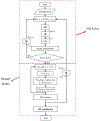Multiscale modeling of hemolysis during microfiltration
- PMID: 33235552
- PMCID: PMC7682248
- DOI: 10.1007/s10404-020-02337-3
Multiscale modeling of hemolysis during microfiltration
Abstract
In this paper, we propose a multiscale numerical algorithm to simulate the hemolytic release of hemoglobin (Hb) from red blood cells (RBCs) flowing through sieves containing micropores with mean diameters smaller than RBCs. Analyzing the RBC damage in microfiltration is important in the sense that it can quantify the sensitivity of human erythrocytes to mechanical hemolysis while they undergo high shear rate and high deformation. Here, the numerical simulations are carried out via lattice Boltzmann method and spring connected network (SN) coupled by an immersed boundary method. To predict the RBC sublytic damage, a sub-cellular damage model derived from molecular dynamic simulations is incorporated in the cellular solver. In the proposed algorithm, the local RBC strain distribution calculated by the cellular solver is used to obtain the pore radius on the RBC membrane. Index of hemolysis (IH) is calculated by resorting to the resulting pore radius and solving a diffusion equation considering the effects of steric hinderance and increased hydrodynamic drag due to the size of the hemoglobin molecule. It should be mentioned that current computational hemolysis models usually utilize empirical fitting of the released free hemoglobin (Hb) in plasma from damaged RBCs. These empirical correlations contain ad hoc parameters that depend on specific device and operating conditions, thus cannot be used to predict hemolysis under different conditions. In contrast to the available hemolysis model, the proposed algorithm does not have any empirical parameters. Therefore, it can predict the IH in microfilter with different sieve pore sizes and filtration pressures. Also, in contrast to empirical correlations in which the Hb release is related to shear stress and exposure time without considering the physical processes, the proposed model links flow-induced deformation of the RBC membrane to membrane permeabilization and hemoglobin release. In this paper, the cellular solver is validated by simulating optical tweezers experiment, shear flow experiment as well as an experiment to measure RBC deformability in a very narrow microchannel. Moreover, the shape of a single RBC at the rupture moment is compared with corresponding experimental data. Finally, to validate the damage model, the results obtained from our parametric study on the role of filtration pressure and sieve pore size in Hb release are compared with experimental data. Numerical results are in good agreement with experimental data. Similar to the corresponding experiment, the numerical results confirm that hemolysis increases with increasing the filtration pressure and reduction in pore size on the sieve. While in experiment, the RBC pore size cannot be measured, the numerical results can quantify the RBC pore size. The numerical results show that at the sieve pore size of 2.2 μm above 25 cm Hg, RBC pore size is above 75 nm and RBCs experience rupture. More importantly, the results demonstrate that the proposed approach is independent from the operating conditions and it can estimate the hemolysis in a wide range of filtration pressure and sieve pore size with reasonable accuracy.
Keywords: Hemolysis; High deformation; High shear rate; Microfiltration; Multiscale modeling; Red blood cell.
Figures















Similar articles
-
Prediction of mechanical hemolysis in medical devices via a Lagrangian strain-based multiscale model.Artif Organs. 2020 Aug;44(8):E348-E368. doi: 10.1111/aor.13663. Epub 2020 Mar 5. Artif Organs. 2020. PMID: 32017130 Free PMC article.
-
A Cellular Model of Shear-Induced Hemolysis.Artif Organs. 2017 Sep;41(9):E80-E91. doi: 10.1111/aor.12832. Epub 2017 Jan 3. Artif Organs. 2017. PMID: 28044355 Free PMC article.
-
A Red Blood Cell Model to Estimate the Hemolysis Fingerprint of Cardiovascular Devices.Artif Organs. 2018 Jan;42(1):58-67. doi: 10.1111/aor.12937. Epub 2017 Jul 19. Artif Organs. 2018. PMID: 28722138
-
Numerical simulations of deformation and aggregation of red blood cells in shear flow.Crit Rev Biomed Eng. 2013;41(4-5):425-34. doi: 10.1615/critrevbiomedeng.2014010689. Crit Rev Biomed Eng. 2013. PMID: 24941417 Review.
-
Hemolysis in cardiac surgery patients undergoing cardiopulmonary bypass: a review in search of a treatment algorithm.J Extra Corpor Technol. 2008 Dec;40(4):257-67. J Extra Corpor Technol. 2008. PMID: 19192755 Free PMC article. Review.
Cited by
-
A numerical study on drug delivery via multiscale synergy of cellular hitchhiking onto red blood cells.Nanoscale. 2021 Oct 28;13(41):17359-17372. doi: 10.1039/d1nr04057j. Nanoscale. 2021. PMID: 34590654 Free PMC article.
-
Effect of intercellular collisions on red blood cell membrane damage.Sci Rep. 2025 Jul 1;15(1):20698. doi: 10.1038/s41598-025-01344-0. Sci Rep. 2025. PMID: 40595671 Free PMC article.
-
Quantitative absorption imaging of red blood cells to determine physical and mechanical properties.RSC Adv. 2020;10(64):38923-38936. doi: 10.1039/d0ra05421f. Epub 2020 Oct 23. RSC Adv. 2020. PMID: 33240491 Free PMC article.
-
Numerical simulation of cellular blood flow in curved micro-vessels with saccular aneurysms: Effect of curvature degree and hematocrit level.Biomicrofluidics. 2024 Apr 29;18(3):034101. doi: 10.1063/5.0203220. eCollection 2024 May. Biomicrofluidics. 2024. PMID: 38726374 Free PMC article.
-
Ca2+-dependent vesicular and non-vesicular lipid transfer controls hypoosmotic plasma membrane expansion.bioRxiv [Preprint]. 2024 Oct 21:2024.10.20.619261. doi: 10.1101/2024.10.20.619261. bioRxiv. 2024. Update in: BMC Biol. 2025 Jul 9;23(1):207. doi: 10.1186/s12915-025-02309-5. PMID: 39484559 Free PMC article. Updated. Preprint.
References
-
- Aaron N, Jacobson L (2015) Left ventricular assist device In: Jacobson L, Okuda Y, Godwin S (eds) SimWars simulation case book: emergency medicine. Cambridge University Press, Cambridge, pp 104–107. 10.1017/CBO9781107111011.026 - DOI
-
- Abkarian M, Faivre M, Horton R, Smistrup K, Best-Popescu CA, Stone HA (2008) Cellular-scale hydrodynamics. Biomed Mater 3(3):34011–34013 - PubMed
-
- Al Jarallah AS, Duncan WJ, Broecker L, Allen L, Cornel G (1997) The Hemopump as a left ventricular assist device in pediatric applications: initial Canadian applications. Can J Cardiol 13(5):489–494 - PubMed
-
- Arora D (2005) Computational hemodynamics: hemolysis and viscoelasticity. Rice University, Houston
Grants and funding
LinkOut - more resources
Full Text Sources
